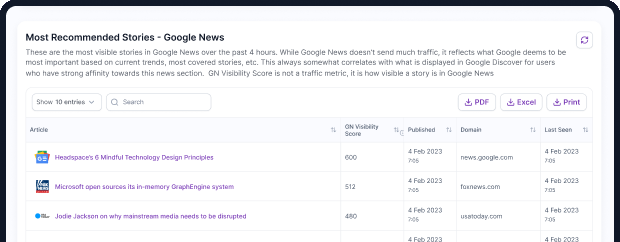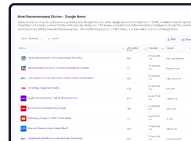Unlocking Google Discover: A Comprehensive Guide for Publishers and Content Creators

Unlocking Google Discover: A Comprehensive Guide for Publishers and Content Creators
Google Discover, a powerful content recommendation engine, has become an essential source of traffic for websites of all kinds. Unlike traditional search, where users actively seek information, Discover proactively provides users with content tailored to their interests. This personalized approach has made Discover a valuable tool for publishers and SEOs looking to reach a wider audience and drive engagement.
In this blog post, we'll delve into the inner workings of Google Discover, drawing on insights from a recent webinar by John Shehata, CEO and founder of News Dash. John, a seasoned SEO expert with over 24 years of experience, shared his expertise on how to optimize content for Discover, based on an analysis of a staggering 654 trillion impressions and 176 million pages.
We'll cover a wide range of topics, including:
- Understanding the mechanics of Google Discover and how it personalizes content recommendations.
- Eligibility criteria and the classification process that determines which content appears in Discover feeds.
- Eleven actionable strategies to optimize your content for Discover, backed by data and real-world examples.
- Eleven common reasons why websites experience traffic loss from Discover and how to address them.
What is Google Discover?
Google Discover is an AI-driven content recommendation engine available on mobile devices. It provides a personalized feed of articles, images, and videos based on a user’s interests and activities. While similar to social media platforms like Instagram or Facebook in concept, Discover is unique as it suggests content without the need for user searches.
How Does Google Discover Work?
The algorithm behind Google Discover focuses on a combination of entities, topics, and user interests, all derived from a user's interaction with Google’s ecosystem, including Chrome and YouTube. It uses data from the Google Knowledge Graph and Topic Layer to understand connections between entities and topics over time, allowing Google to present users with a feed that evolves with their preferences.
Why Should You Care About Google Discover?
Google Discover has an estimated 2 billion active users as of 2024, and it continues to grow. What makes it even more exciting is its ability to send repeat traffic. When users engage with your content, Discover pushes even more of your stories to their feeds, which creates a feedback loop of continuous visibility.
Google Discover Eligibility and Classification
Crawling and Indexing
To even be considered for Google Discover, your content must first be crawled and indexed by Google. This is the same process that happens for traditional search results. Google's bots will visit your website, follow links to your content, and add it to their index.
Eligibility
Once your content is indexed, it goes through an eligibility check for Google Discover. Here are the key criteria:
- Fresh URL: The content should be new and not a duplicate of something already on your site or elsewhere on the web.
- Adherence to Content Policies: Your content must comply with Google Discover's content policies, which we'll discuss in the next section.
- High-Resolution Images: Include at least one high-resolution, large image that is at least 1200 pixels wide.
- Mobile-Friendliness: Your website and content must be easily accessible and readable on mobile devices.
- Clear EAT Signals: Provide clear dates, bylines, and author information to establish expertise, authoritativeness, and trustworthiness.
- Timely Content: While evergreen content can appear in Discover, timely and trending content is generally favored.
- SafeSearch Compliance: Your content must not violate SafeSearch guidelines, meaning it should be free of explicit or harmful content.
The Sandbox
If your content meets the eligibility criteria, it enters a "sandbox" phase where Google further evaluates it before releasing it into Discover feeds. This phase involves two key processes:
- Content Classification: Google analyzes your content using natural language processing (NLP) to identify the entities (people, organizations, locations, etc.) and topics (categories) it covers. This helps Google understand the context and relevance of your content in relation to user interests.
- Audience and Social Data Gathering: Google assesses whether your content has sufficient audience interest and social buzz. This is done by analyzing Chrome user data and social media activity related to your URL. This step helps determine the potential reach and engagement of your content.
Interest Matching
The final step is interest matching, where Google connects your content's classification (entities and topics) with users who have shown interest in similar content. This is how the personalization of Discover feeds happens. Your content will appear in the feeds of users whose interests align with the entities and topics identified in your article.
11 Ways to Optimize for Google Discover
- Understand User Interests: Analyze user interests driving traffic to your site. Tools like Google Search Console and DiscoverPulse can help identify trending topics and entities.
- Timely Content: Publish content that’s relevant to current events or trends. Discover’s algorithm favors fresh, timely articles.
- Trends-Adjacent Content: If your site doesn’t cover breaking news, produce content that aligns with trending topics. For example, if a celebrity wedding is trending, an architecture site could publish content about the celebrity’s home.
- Craft Engaging Titles: Titles that spark curiosity without being clickbait tend to perform well. Headlines should deliver on the promise and avoid misleading users.
- High-Quality Images: Use large, vibrant images in a 16:9 ratio. Avoid logos or stock images that may reduce engagement.
- Optimize for Engagement: User engagement metrics such as click-through rates (CTR) and dwell time are crucial indicators for Google Discover. Encourage interaction and keep users on your page longer.
- Boost Social Buzz: Social media plays a significant role in Discover’s algorithm. Engage with users on platforms like Twitter, Reddit, and Facebook to create buzz around your content.
- Enhance Mobile-Friendliness: Google Discover is a mobile product. Make sure your website is fast and optimized for mobile devices.
- Enhance E-E-A-T (Expertise, Authoritativeness, Trustworthiness): Establish trust with Google by providing detailed author bios, linking to social media profiles, and using a secure (https) site.
- URL Refreshing: When traffic on a URL starts to fade, consider refreshing the content. Republish it with a new URL, updated timestamps, and a fresh image to re-engage Discover.
- Spy on Competitors: Use tools like DiscoverPulse to track what your competitors are publishing in Google Discover and adjust your content strategy accordingly.
Let's tackle them one by one:
1. Uncover User Interests
Even though you can't directly see the individual interests of every user who sees your content on Discover, you can figure out what groups of users with similar interests are clicking on. Think of it like reverse engineering the process:
Analyze your existing Discover data: Look at which entities (people, organizations, locations) and categories (topics) are already performing well for you in Discover. This data is a goldmine for understanding what resonates with your audience.
Double down on what works: If articles about a certain celebrity or topic consistently get a lot of impressions and clicks, create more content around those entities and categories.
Test and expand: Identify potential areas of interest that you haven't explored much. If you have a few articles about a specific topic that performed well, try increasing content production in that area and see if it leads to more Discover traffic.
How to Analyze Your Content
Gather Discover data: Use Google Search Console (GSC) or Google BigQuery to get a daily feed of which URLs are getting Discover traffic. Keep in mind there's a slight delay in GSC data.
Extract the content: Get the full text of each page that's performing well in Discover.
Use Natural Language Processing (NLP): Google's Natural Language Processing API can analyze your content and identify the key entities and categories for each article. This gives you valuable insight into how Google understands your content.
Group and analyze: Combine the NLP data with impressions, clicks, and click-through rates (CTR) from your Discover report. This allows you to see which topics and entities are driving the most impressions and engagement.
Prioritize Impressions
When analyzing your Discover data, pay close attention to impressions. Impressions are the most important metric because they indicate Google's decision to show your content to users. Clicks are important, but they mainly reflect the effectiveness of your headlines and images. Focus on increasing impressions to maximize your Discover reach.
Example:
Imagine you have a news website. After analyzing your data, you find that articles about pets consistently generate three times more impressions per article than articles about news. This indicates a strong interest in pet-related content among your Discover audience.
Even if you continue to write about news, consider increasing your output of pet-related articles to capitalize on this interest and potentially drive more traffic.
By understanding the interests of your Discover audience, you can create more content that resonates with them and increase your chances of appearing in their feeds.
Common Reasons for Traffic Loss in Google Discover
While Discover can drive significant traffic, it can also be unpredictable. Some common reasons for traffic drops include:
- Core Algorithm Updates: Google’s updates can affect traffic. It’s essential to monitor these changes and adjust your content accordingly.
- SafeSearch Triggers: Explicit or inappropriate content can trigger Google’s SafeSearch filters, leading to decreased visibility.
- Weak E-E-A-T: Sites that lack trust signals, such as unclear bylines or poorly written content, may see drops in Discover traffic.
- Seasonal Content: If your content is too seasonal or evergreen, it may not align with users’ changing interests.
- Lack of Social Buzz: Ensure your content is shared and discussed on social platforms to maintain Discover visibility.
- Google algorithm updates affecting site quality assessment
- Presence of unsafe or adult content triggering SafeSearch filters
- Slow mobile page speed
- Removal from Google News (for news publishers)
- Technical issues affecting crawling and indexing
- Weak E-E-A-T signals
- Highly seasonal content or lack of fresh content
- Low social engagement around content
- Thin content overly focused on Discover optimization
- Poor user experience, especially related to ads
- Violations of Google Discover content policies
1. Google Algorithm Updates
The most common reason for fluctuations in Google Discover traffic is Google's algorithm updates, particularly the core updates. These updates aim to improve the overall quality of search results and can significantly impact how content is ranked and displayed in Discover feeds.
Quality Fluctuations: Core updates often involve reassessing the quality of existing content. If Google deems your content's quality to have decreased, it may result in lower impressions and clicks from Discover.
Unpredictability: It's important to remember that algorithm updates can have both positive and negative effects on your traffic. Some updates may boost your visibility, while others may cause it to decline.
2. SafeSearch Filters
Google's SafeSearch filter is designed to exclude explicit or sensitive content from search results and Discover feeds. If a significant portion of your content is flagged as "not safe," it can lead to a substantial drop in Discover traffic.
Content Categories: This often affects websites with content related to topics such as violence, sexually suggestive themes, or certain types of sports.
Addressing SafeSearch Issues: The most effective solution is to move the affected content to a separate subdomain or subfolder. You can also add the meta name="rating" content="adult" tag to individual pages, but this may not always be sufficient.
3. Mobile Friendliness and Core Web Vitals
Google Discover is a mobile-first product, so ensuring your website is mobile-friendly is crucial. Poor mobile usability or low Core Web Vitals scores can negatively impact your visibility in Discover.
Mobile Optimization: Make sure your website loads quickly, is easy to navigate, and provides a seamless user experience on mobile devices.
Core Web Vitals: Pay attention to metrics like Largest Contentful Paint (LCP), First Input Delay (FID), and Cumulative Layout Shift (CLS) to ensure your website meets Google's performance standards.
4. Loss of News Publisher Status
If your website primarily focuses on news content, maintaining a strong news presence is essential for Discover visibility. Over time, if your website shifts away from its news focus or fails to meet Google's news guidelines, it may lose its status as a news publisher, leading to a decline in Discover traffic.
Maintain News Standards: Ensure your website adheres to Google's news policies and guidelines, including content quality, EAT signals, and transparency.
5. Other Technical and Content-Related Issues
Several other factors can contribute to Discover traffic loss:
Crawling and indexing errors: Make sure Google can easily access and index your content.
Weak EAT signals: Establish expertise, authoritativeness, and trustworthiness by providing clear author information, bylines, and publication details.
Seasonal content: Traffic for seasonal content naturally fluctuates throughout the year.
Thin or low-quality content: Focus on creating in-depth, informative, and engaging content.
Poor user experience: Address issues like intrusive ads, slow loading times, or confusing navigation.
Content policy violations: Ensure your content complies with Google Discover's policies.
Analyzing and Addressing Traffic Loss
Before attempting to fix any issues, it's important to analyze your Discover data to understand the root cause of the decline. Consider the following:
Content Categories: Are you losing traffic across all categories, or is it specific to certain topics?
Seasonality: Is the decline related to seasonal trends?
Competitor Analysis: Are other publishers in your niche experiencing similar drops in traffic?
Key Takeaways
- Focus on impressions rather than clicks when analyzing Discover performance.
- Leverage "trends-adjacent" content to ride the wave of popular topics.
- Use OG titles to experiment with more engaging headlines for Discover.
- Pay attention to content classification and how Google categorizes your articles.
- Don't neglect the importance of social signals and audience traction.
- Be cautious with URL refreshing tactics and only use them for news content.
- Continuously monitor and adapt to changes in Discover visibility across different categories.
Conclusion
Google Discover represents a significant opportunity for publishers to reach engaged audiences. By understanding its mechanisms and implementing these optimization strategies, content creators can increase their visibility in this growing platform. However, it's crucial to maintain a balanced approach, focusing primarily on creating high-quality, user-centric content while viewing Discover as a complementary traffic source rather than a primary strategy.
As Google continues to evolve Discover, staying informed about best practices and consistently analyzing performance will be key to long-term success in this dynamic content ecosystem.
























